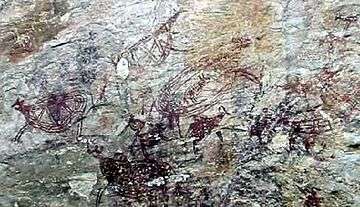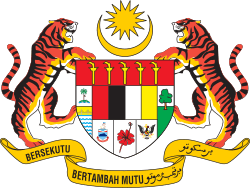Prehistoric Malaysia
The earliest anatomically modern humans skeleton in Peninsular Malaysia, Perak Man, dates back 11,000 years and Perak Woman dating back 8,000 years, were both discovered in Lenggong. The site has an undisturbed stone tool production area, created using equipment such as anvils and hammer stones. The Tambun Cave paintings are also situated in Perak. From East Malaysia, Sarawak's Niah Caves, there is evidence of the oldest human remains in Malaysia, dating back 40,000 years.

Chronology
35,000+ years ago – Paleolithic (Early Stone Age)
Niah Caves in Sarawak is an important prehistoric site where human remains dating to ca. 40,000 years ago have been found.[1] Archeologists have claimed a much earlier date for stone tools found in the Mansuli valley, near Lahad Datu in Sabah, but precise dating analysis has not yet been published.[2]
10,000–5,000 years ago- Neolithic (New Stone Age)
Archaeological finds from the Lenggong valley in Perak show that people were making stone tools and using jewellery. The archaeological data from this period come from cave and rock shelter sites, and are associated with Hoabinhian hunter-gatherers. It is believed that Neolithic farmers made their entrance in this region between 3–4000 years ago.[3]
2,500 years ago – Bronze Age
More people arrived, including new tribes and seafarers. The Malay Peninsula became the crossroads in maritime trades of the ancient age. Seafarers who came to Malaysia's shores included Indians, Javanese and Chinese among others. Ptolemy named the Malay Peninsula the Golden Chersonese.
Out of Sundaland Migration theory
A study from Leeds University and published in Molecular Biology and Evolution, examining mitochondrial DNA lineages, suggested that humans had been occupying the islands of Southeast Asia for a longer period than previously believed. Population dispersals seem to have occurred at the same time as sea levels rose, which may have resulted in migrations from the Philippine Islands to as far north as Taiwan within the last 10,000 years.[4] The population migrations were most likely to have been driven by climate change – the effects of the drowning of an ancient continent. Rising sea levels in three massive pulses may have caused flooding and the submerging of the Sunda continent, creating the Java and South China Seas and the thousands of islands that make up Indonesia and the Philippines today.
A 2009 genetic study published by the 2009 Human Genome Organization Pan-Asian SNP Consortium found that Asia was originally settled by humans via a single southern route. The migration came from Africa via India, into Southeast Asia and what are now islands in the Pacific, and then later up to the eastern and northern Asian mainland.[5]
Genetic similarities were found between populations throughout Asia and an increase in genetic diversity from northern to southern latitudes. Although the Chinese population is very large, it has less variation than the smaller number of individuals living in Southeast Asia, because the Chinese expansion occurred very recently, following the development of rice agriculture – within only the last 10,000 years.
Oppenheimer locates the origin of the Austronesians in Sundaland and its upper regions.[6] Genetic research reported in 2008 indicates that the islands which are the remnants of Sundaland were likely populated as early as 50,000 years ago, contrary to a previous hypothesis that they were populated as late as 10,000 years ago from Taiwan.[7]
Yunnan migration theory
The theory of the Proto Malay people originating from Yunnan is supported by R.H Geldern, J.H.C Kern, J.R Foster, J.R Logen, Slametmuljana, and Asmah Haji Omar. The Proto Malay (Melayu Asli) who first arrived had agricultural skills while the second wave Deutero Malay (mixed blood) who arrived around 1500 BC to dwell along the coastlines had advanced fishery skills. During the migration, both groups intermarried with peoples of the southern islands, such as those from Java (Indonesian), and also with aboriginal peoples of Australoid, Negrito and Melanesoid origin.
Other evidences that support this theory include:
- Stone tools found in the Malay archipelago are analogous to Central Asian tools.
- Similarities between Malay customs and Assamese customs.
Kedah and Melaka
According to Kedah Annals, Kedah Kingdom (630–1136) was founded by Merong Mahawangsa who was claimed to be a descendant of Alexander the Great.
Deutero Malays
Combination of the colonial Kambujas of Hindu-Buddhism faith, the Indo-Persian royalties and traders as well as traders from southern China and elsewhere along the ancient trade routes, these peoples together with the aborigine Negrito Orang Asli and native seafarers and Proto Malays intermarried each other's and thus a new group of peoples was formed and became to be known as the Deutero Malays, today they are commonly known as the Malays.
Mekong Delta
According to the earliest written records (in Chinese), the first recorded civilisation in the Mekong Delta was the 1st century Indianised-Khmer culture of Funan. The Khmer empire of Angkor followed. Neolithic inhabitants of coastal parts of the modern Cambodia region were cultivating rice. It is believed that they were the ancestors of the people living in insular Southeast Asia and islands of Pacific Ocean. They were also knowledgeable in iron and bronze works as well as possessing good navigational skills. (Source: Based on information from John F. Cady, Southeast Asia: Its Historical Development, New York, 1964.)
Oldest Malay text
The Đông Yên Châu inscription around the 4th century AD is the oldest Malay text found. It was written in Old Malay-Cham language, found near Indrapura, Vietnam.
The Kedukan Bukit Inscription of 682 CE was found at Palembang, Indonesia.
Cham-Malay relation
The similarity of the Cambodian Cham language and the Malay language can be found in names of places such as Kampong Cham, Kambujadesa, Kampong Chhnang, etc. and Sejarah Melayu clearly mentioned a Cham community in Parameswara's Malacca around the 15th century. Cham is related to the Malayo-Polynesian languages of Malaysia, Indonesia, Madagascar and the Philippines. In the mid 15th century, when Cham was heavily defeated by the Vietnamese, some 120,000 were killed and in the 17th century the Champa king converted to Islam.[8] In the 18th century the last Champa Muslim king Pô Chien gathered his people and migrated south to Cambodia while those along the coastline migrated to the nearest peninsula state Terengganu, approximately 500 km or less by boat, and Kelantan. Malaysian constitution recognises the Cham rights to Malaysian citizenship and their Bumiputera status. Now that the history is interlinked, there is a possibility that Parameswara's family were Cham refugees who fled to Palembang before he fled to Tumasik and finally to Malacca. One of the last Kings of Angkor of the Khmer Empire had the name Paramesvarapada.[9]
See also
- Cham language
- Cham people
- Early history of Burma
- Early history of Cambodia
- History of Southeast Asia
- Kamboja
- Kambojas and Kambodia
- Kampong Cham of Cambodia.
- Origin of Pallava
- Pahang River
- Pallava
- Prehistoric Asia
- Prehistoric Indonesia
- Prehistoric Thailand
References
- Barker, Graeme; et al. (2007). "The 'human revolution' in lowland tropical Southeast Asia: the antiquity and behavior of anatomically modern humans at Niah Cave (Sarawak, Borneo)". Journal of Human Evolution. Elsevier. 52 (3): 243–261. doi:10.1016/j.jhevol.2006.08.011. PMID 17161859.
- Fong, Durie Rainer (10 April 2012). "Archaeologists hit 'gold' at Mansuli". The Star. Archived from the original on 12 April 2012. Retrieved 15 April 2012.
- Lekenvall, Henrik. LATE STONE AGE COMMUNITIES IN THE THAI-MALAY PENINSULA. Journal of Indo-Pacific Archaeology 32 (2012): 78-86.
- Dr. Martin Richards. "Climate Change and Postglacial Human Dispersals in Southeast Asia". Oxford Journals. Retrieved 2010. Check date values in:
|accessdate=(help) - Press release: Agency for Science, Technology and Research (A*STAR), Singapore (10 December 2009). "Genetic ancestry highly correlated with ethnic and linguistic groups in Asia". Retrieved 14 June 2012.CS1 maint: multiple names: authors list (link)
Paper: The HUGO Pan-Asian SNP Consortium (11 December 2009). "Mapping Human Genetic Diversity in Asia". Science. 326 (5959): 1541–1545. doi:10.1126/science.1177074. PMID 20007900. - Oppenheimer 1999
- New research forces U-turn in population migration theory
- The Book of Anushirwan, The Cham Muslims of Southeast Asia: A Historical Note
- Crawford's 1822 Malay of Champa
- Nik Hassan Shuhaimi Nik Abdul Rahman (1998). The Encyclopedia of Malaysia : Early History, Volume 4. ISBN 981-3018-42-9.
- Prof. Dato' Dr. Asmah Haji Omar (1998). The Encyclopedia of Malaysia : Languages and Literature, Volume 9. ISBN 981-3018-52-6.

